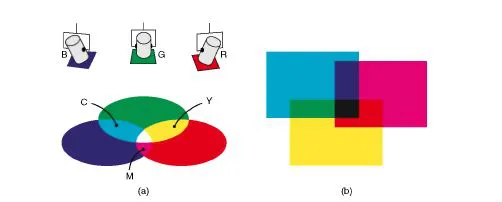![]()
1 Colour in photography
This chapter describes the properties of light with regard to colour. It presents the principles that have been applied to colour photography, both analogue and digital. In the beginning of the chapter you will see how colour is produced from visible light and how we can get information about the colour of a light source. Colour originates from different types of sources and you will see how it is affected by their properties. One of the major issues in colour photography is the difference in colour between different types of light sources. This is important when you want to achieve colour-balanced scenes in your photographs. This chapter presents ways of measuring the colour of the light sources and controlling colour.
Colour exists because of the way our visual system interprets the sensation of light. An introduction to the human visual system is therefore included in this chapter, and is focused on our colour vision. This includes the Young–Helmholtz trichromatic theory, where colour photography and imaging is based, and the opponent colour theory.
Working with colour has made the development of colour classification systems essential. With these systems any colour can be described by a unique set of numbers. Several systems have been devised and three of them are presented in this chapter. Colour, however, is a perceptual phenomenon. The characteristics of human vision have therefore been taken into account in the design of some colour classification systems.
Finally, the chapter discusses the effect of subjective judgement when looking at colour photographs. You will see how colour adaptation of the human visual system affects the colours you see. The effect of eye fatigue and psychological influences on the perception of colour are also presented and discussed.
Light and colour
The sensation of colour is produced by light rays refected or transmitted from an object. A light ray can be considered as an electromagnetic wave, part of the wider series of electromagnetic waves that travel in space, and is described by its wavelength and frequency. The wavelength is the distance between two adjacent corresponding points on the wave train, as shown in Figure 1.1, while the frequency refers to the number of waves passing from a given point over 1 second. The product of wavelength and frequency gives the speed of the wave.
The electromagnetic spectrum extends from wavelengths of 0.0000001 nm to 1000 km. What we call light is the visible part of the spectrum, from approximately 400 nm to approximately 700 nm. If you take into account that 1 nm is equal to 1/1 000 000 000 m, you see that the visible spectrum is a very small part of the electromagnetic spectrum.
Figure 1.1 Wavelength is the distance between two adjacent corresponding points on the wave train.
Figure 1.2 An infrared photograph captured with a Sony DSC-F707 camera using a Heliopan RG780 infrared filter.
Below 390 nm lies the ultraviolet (UV) band of radiation and above 760 nm lies the infrared (IR) band. UV and IR radiation is, therefore, not visible. In digital cameras, charge-coupled device (CCD) and complementary metal oxide semiconductor (CMOS) electronic sensors (see Chapter 6) are sensitive to IR rays. To eliminate the effect of the IR rays, a special filter is placed in front of the imaging sensor. In some digital cameras this filter can be removed and you can record in the IR region. Another option is to use a filter that passes only the IR radiation (Figure 1.2). With film cameras you can record the IR light with the use of an IR film. Photographic film is sensitive to a wavelength range between 350 and 700 nm, and so it is sensitive to UV rays. For this reason, a UV filter is usually placed in front of the lens, to stop UV rays reaching the film. See Chapter 11 for UV and IR photography.
X-rays and gamma rays have wavelengths below the UV rays. Although they do not form part of the visible spectrum there are applications, such as in medical imaging, where these rays are recorded. Rays of longer wavelengths than IR include radar and radio waves.
White light is a mixture of colour rays. In the late 1600s, Sir Isaac Newton showed that when white light falls on a clear glass prism, it is not only deviated but also refracted to many colour rays, as shown in Figure 1.3, in the following order: red, orange, yellow, green, blue, indigo and violet. The magnitude of refraction depends on the wavelength of the ray, so the white light was shown to consist of rays with different wavelengths. These correspond to the colours we see in the spectrum. See also page 57 for more details on refraction and dispersion when light falls on glass.
Figure 1.3 White light refracted yelding colours of the visible spectrum.
The human visual system
Colour exists due to our visual perception and specifically our colour visual system, which interprets the different wavelength compositions of light as colour (Figure 1.4).
Many ingenious inventions are based on 'observations of nature'. The way colour films and imaging sensors work owes much to scientists' basic study of just what colour is, and how human eyes and brains respond to coloured surroundings. In 1802 Thomas Young suggested that the retina of the human eye does not contain receptors for each discernible hue. Instead it has a mixture of three different kinds of receptor - sensitive to red, green and blue. Young called these colours the primary colours of light (not the same as pigment primary colours, familiar to the artist as blue, yellow and red). This 'three-colour vision' gives your brain the sensation of colour which it derives from the combination of signals it receives. The theory was quantified by Helmholtz in 1866 and is known as the Young-Helmholtz theory of colour vision (also known as trichromatic theory). Another theory developed at the end of the nineteenth century by Ewald Hering was the opponent colour theory. According to this theory colour is perceived with three chromatic channels: green-red, yellow-blue and white-black. Therefore, a colour cannot be perceived as reddish-greenish or yellowish-bluish. Some three-dimensional colour spaces such as CIELAB are based on the opponent colour theory. Current colour theories combine the trichromatic theory and the opponent colour theory.
Today it is well established that our retinas contain many millions of rod- and cone-shaped cells. The rods are more sensitive to light but have no colour discrimination. They are distributed in the peripheral area of the retina, where the image is formed. There are about 75-150 million rods in that area. The less sensitive cones react to colour with their three types of reception determined by chemical content. They are concentrated in the centre of the retina and they are fewer in number than the rods, about 6-7 million.
Some aspects of colour vision are not fully explained by the trichromatic theory but the discoveries of these nineteenth-century scientists remain highly relevant for understanding colour photography. At the same time, remember that your eyes are virtually an extension of your brain, connected to it by over 750000 fibres in each optic nerve. In dealing with colour vision the brain's ability to interpret is as relevant as the actual stimuli received from eye response.
Figure 1.4 Colour is perceived when wavelengths from a light source are refected by the surface of an object. The human visual system interprets the wavelength compositions as the colour of the object.
Methods of colour reproduction
Two methods of colour reproduction exist: the additive method and the subtractive method.
Additive method
James Clerk Maxwell proved the trichromatic theory in the 1850s by demonstrating with light from blue-, green- and red-filtered lanterns overlapped on one screen. Dimming or brightening individual lanterns recreated all the colours of the spectrum, while an equal mixture of the three primary colours formed a patch of white. Combination of two primary colours results in a secondary colour. This is shown in Figure 1.5(a). This type of colour mixing is called additive. Note that during the 1870s and 1880s the technique of pointillism was used by French Impressionist painters such as Monet, Pissaro and Seurat. Pointillism is the technique of juxtapositioning tiny brush strokes in paints of strong luminous colours and subtle tones. It is a significant fact that the very first colour photography materials to go on sale were manufactured in France (Lumière’s ‘Autochrome’, 1907) and worked on what is known as the additive principle. With the additive method, you can create any colour by varying the proportions and intensities of red, green and blue points in an image. When viewing an image from a distance, the eye sees a uniform colour and not individual colour points. One of the applications of this method is in the design of television and computer displays (see page 183). The colours are formed by very small red, green and blue pixels, which you can discriminate only by very close inspection of the screen. The additive method has also been used for instant picture materials and for the design of digital imaging sensors.
Subtractive method
Another method, the subtractive method, has its origins in work by the French scientist Luis Ducos du Hauron in the late 1800s. He published a book, Les Couleurs en Photographie, in 1868, forecasting several of the colour reproduction systems we now use. However, it was not until the 1880s that Dr Hermann Vogel’s research in Germany into sensitizing additives made possible orthochromatic and panchromatic emulsions to add to the blue-sensitive materials used exclusively up until this time. Panchromatic response to all colours, and ability to control colour sensitivity, unlocked the door to practical colour photography.
Figure 1.5 Additive (a) and subtractive (b) methods to create colour. In the additive method, mixing of two primary colours, red, green or blue, creates a complementary colour, cyan, magenta or yellow. Mixing of all three colours results in white. In the subtractive method, two complementary colours create a primary colour.
The subtractive method is based on light absorption using the complementary colours cyan, magenta and yellow. We can take, as an example, a set of cyan, magenta and...





